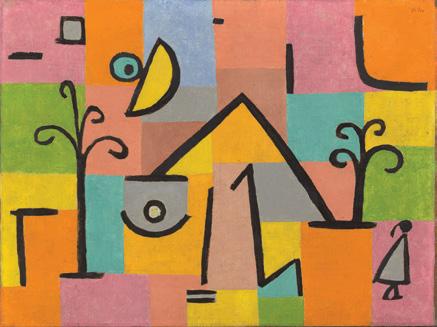
9 minute read
Abstraction and Calligraphy
Abstraction and Calligraphy
In keeping with the third season’s theme of exchanges between East and West, this international exhibition, from the Louvre Abu Dhabi, marks the second major collaboration with the Centre Pompidou. Charting sites of mutual inspiration around the world, and dedicated to artistic practices of abstraction, the show explores how 20th-century artists established a new visual language by merging text and image, inspired by the earliest forms of mark-making and, in particular, calligraphy. Te exhibition brings together 101 works on loan from 16 partner institution collections, alongside seven works from the museum’s permanent collection – and two monumental artworks by contemporary artists whose currentday practices bring recurring themes of the exhibition to life.
Advertisement
Organised in four themed sections, the exhibition investigates the timeline of abstraction as a new visual language established by artists in the early 20th century. By highlighting this rich cultural exchange, the exhibition shows how the abstract movements were inspired by a plethora of signs and symbols, philosophies, and artistic techniques from cultures and societies far from European and American capitals. Artists including Paul Klee, André Masson, Vassily Kandinsky, Cy Twombly, Lee Krasner, and Jackson Pollock sought a new universal language that enabled them to express their emotions in response to a rapidly changing society, breaking away from fgurative conventions. Te show also focuses on how these same infuences informed the practices of artists working in the Islamic world – from Dia Azzawi and Anwar Jalal Shemza, to Ghada Amer, Shirazeh Houshiary, and Mona Hatoum. Te exhibition fnishes with installations from two contemporary artists, eL Seed and Sanki King, exploring how artists today are still seeking new visual forms to respond to current societal changes.
Te frst section of the exhibition explores pictograms – symbolic fgurative images that represented words and ideas in writing in ancient civilisations in Mesopotamia and Egypt. Work presented include a painting by Swiss-German artist Paul Klee, who – inspired by his travels to Tunisia – created artwork that combined elements of images and letters stemming from his fascination with Egyptian hieroglyphics. His work infuenced artists such as Joaquín Torres-García from Spain, Iraqi artist Dia AlAzzawi and Pakistani artist Anwar Jalal Shemza. Tis section also include works from American artist Adolph Gottlieb, inspired by images from Native American art, and French artist André Masson, who was inspired by 17th-century Indian fgurative inscriptions and Arabic calligraphy.
In line with the history of writing, the second section focuses on signs, which by their very form can express universal ideas. Works on show will include studies of signs by Russian artist Vassily Kandinsky, considered by many to be one of the inventors of abstract art. As an act of resistance to the Western world ravaged by war, many artists turned to Japan and China for inspiration. Te signs traced in works by French-Hungarian painter Judit Reigl and GermanFrench painter Hans Hartung echo symbols used by Chinese and Japanese calligraphers. Te show also include works from French artists Georges Mathieu, who tried to develop a lyric and rapid gesture, and Julius Bissier, who was infuenced by the Chinese philosophy of Taoism. Finally, Mona Hatoum’s works endeavour to create a new alphabet of signs through found objects.
As Didier Ottinger in his essay in the catalogue (Forms of Dialogue Between East and West), comments, ‘Te artist to whom the gilded legend of modern art attributes the frst “abstract” work, Wassily Kandinsky, confrms the motives that Janco ascribes to the inventors of the frst wave of abstract art. In 1904, fve years before a painting, placed upside down in his workshop, revealed itself to be “of an indescribable beauty, impregnated with a great inner fre”, without any subject, any fgure contributing to this “beauty”. Kandinsky spent three months in Tunisia, where he travelled from Tunis to Carthage, from Kairouan to Sousse and Sidi Bou Said. Aspiring to produce a form of painting capable of provoking a “spiritual awakening” the artist found in the decorative arts, architecture and calligraphy of Islam a model that triggered a ‘particular spiritual sound’. On his return to Munich, Kandinsky encountered an exhibition of Japanese and East Asian art, on which he reported in the review Apollon in October 1909. Having noted the “Oriental gift for an extraordinary breadth and abstraction in the handling of colour and form”. Continuing, “So much that is part of Western art becomes clear when one sees the infnite variety of the works of the East, which are, nonetheless, subordinated to and united by the fundamental tone”.
Ottinger also explains of Klee’s painting in the exhibition, Oriental Bliss from 1938, ‘Accompanied by fellow-painters August Macke and Louis Moilliet, Paul Klee visited Tunisia in the spring of 1914. His discovery of the ‘chequerboard’ layout of the gardens of Kairouan inspired him to make drawings and watercolours, which foreshadowed his “magic square” compositions (a series of works created after 1918). His fascination with the abstract genius of Islamic ornamental art was again expressed in 1921–22, when he gave the title of Carpet of Memory to one of the frst abstract works he created in Tunisia’.
Te third section of the exhibition is devoted to lineaments, revealing how Western artists appropriated the energy of Eastern calligraphy in their brushstrokes to produce free and fuid lines. In opposition to Western artistic inclination, the Surrealist movement invented a drawing technique called Automatism, using automatic movements to express the subconscious. It allowed them to artistically respond to a tumultuous interwar period between World War I and World War II. On display are works by Surrealist André Masson, as well as works by Jackson Pollock,
Universal composition (Universal Art) (1937) by Joaquín Torres-García (1874-1949), oil on cardboard, Centre Pompidou, Paris, Musée national d’art moderne/Centre de création industrielle. Dépôt au LaM Lille métropole musée d’art moderne d’art contemporain et d’art brut (Villeneuve-d’Ascq) Photo © Centre Pompidou, MNAM-CCI, Dist. RMN-Grand Palais / Philippe Migeat Square Composition 6 (1963) by Anwar Jalal Shemza, oil on canvas, Guggenheim Abu Dhabi © Guggenheim Abu Dhabi/© ADAGP
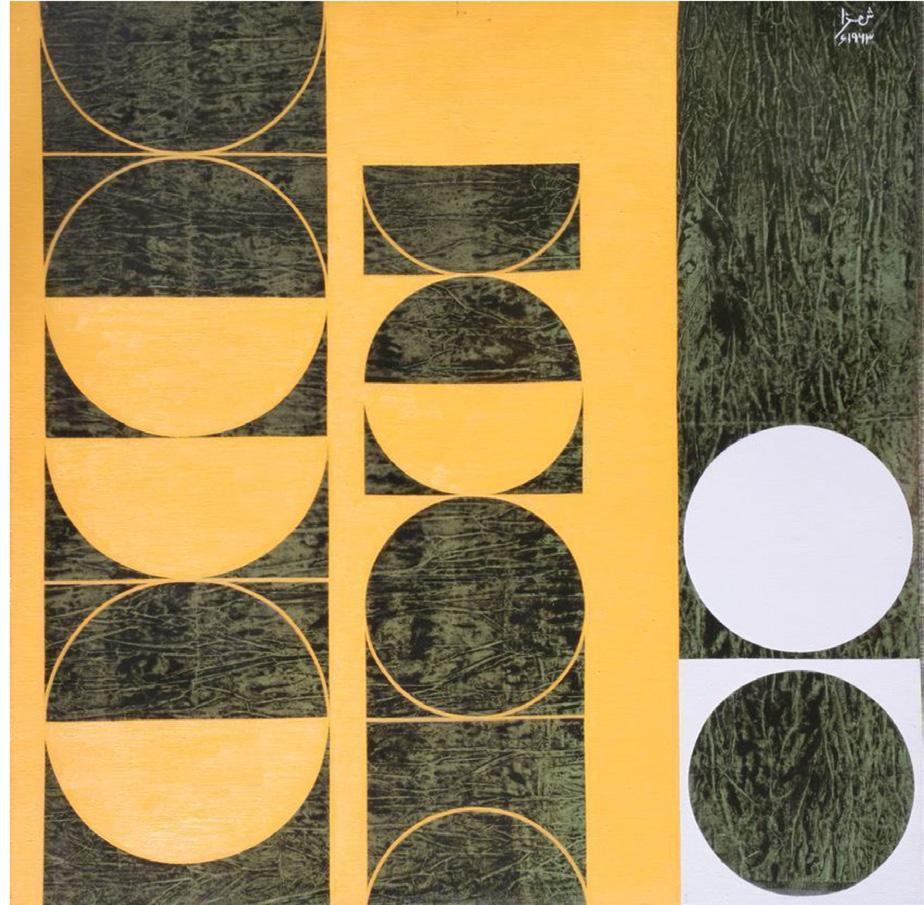
A new visual language for art in the 20th century
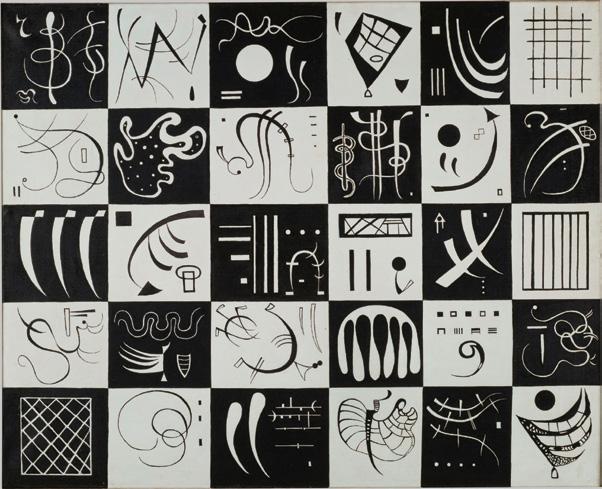
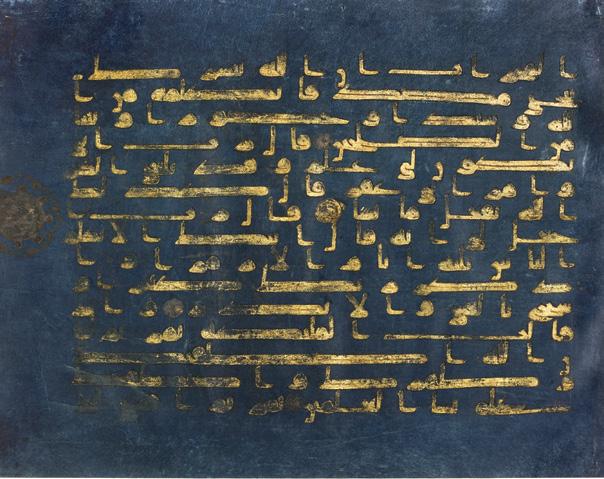
Philip Guston, and Willem de Kooning, who were all infuenced by Masson. Visitors can also see Jean Dubufet’s primitive creations, inspired by a combination of grafti, rock paintings and children’s drawings along with Cy Twombly’s gestural drawings for curtains of the Opéra de Paris and Lee Krasner’s works, which take their inspiration from Kufc script from the Iraqi City of Kufa, the birthplace of Arabic calligraphy.
Te exhibition concludes with a section showing how both Western and Eastern artists incorporated calligraphy into their practice, such as Spanish artist Joan Miró, who referenced how closely painting and poetry are linked in the East. Following in his footsteps, the poets Brion Gysin, Henri Michaux and Christian Dotremont pursued the same path by painting poetry, inspired by their trips to North Africa, China and Lapland, respectively. Henri Matisse’s studies for his illustrated book Jazz, which he called ‘arabesques’ in a tribute to Arabic writing, are also included.
A good example of this crosscultural referencing is a work by Anwar Jalal Shemza. Shemza, who, had studied Persian, Arabic and philosophy at the Punjab University. In 1944, Anwar Jalal Butt enrolled at the Mayo School of Arts in Lahore, graduating in 1947. Under the pseudonym of Anwar Jalal Shemza, he opened a studio in Lahore becoming a major fgure in the cultural life of the city and published Ehsas, an infuential review covering art and architecture. Alongside his activity as a writer, he continued to paint and founded the Lahore Art Circle of abstract artists, together with Ahmed Parvez and Ali Imam. In 1952, he had settled in London, where he returned earlier to study at the Slade School of Fine Art. Frequent visits to the Islamic rooms of the British Museum led him to reconsider the importance of his own culture and to defend a form of modern art that reconciled the dual heritage of abstraction and Islamic art. Te series Compositions that he had begun in 1962 and continued to work on for several years until the vein was worked out, gave him a way out of the impasse represented on the one hand by fguration, on the other by pure geometrical abstraction – both profoundly alien to his culture. Infuenced by the free and joyful abstraction of Paul Klee, Shemza set about creating a new plastic alphabet with a universal signifcance. Te Arabic character meem, the frst letter of the Prophet Muhammad’s name, was the starting point for a variety of shapes, a form of composition combining the lines of the Roman alphabet and the arabesques of Arabic calligraphy
Te exhibition also explores how regional artists, such as Shakir Hassan Al Said and Sliman Mansour, sought to free calligraphy from its purely linguistic function. Tis section, which looks at more contemporary works, is completed by two original monumental artworks from the French-Tunisian artist eL Seed (b 1981) and Pakistani artist Sanki King (b 1990).
Dr Souraya Noujaim, Scientifc, Curatorial and Collections Management Director at the Louvre Abu Dhabi, says of the exhibition, ‘It brings works by masters of abstraction together with sources of myriad infuences. Te calligraphic works are far from a unifed codex of signs and symbols. Tey represent the diversity of cultures, languages – written and visual – and histories that span many continents and centuries and establishes a powerful dialogue between two distinct forms of expression (image and writing) revealing the common ground which unites them both. Appearing in unison, the visual and the verbal come together as one, singular form of expression, recalling what Ibn Khaldun terms “the two faces of thought”.’
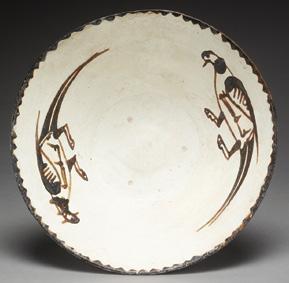
Bowl decorated with birds enclosing the inscription ‘blessing’, 900-1000, Central Asia, ceramic with underglaze slip decoration Louvre Abu Dhabi © Department of Culture and Tourism Abu Dhabi. Photo: Thierry Ollivier
Until 12 June, Abstraction and Calligraphy: Towards a Universal Language, Louvre Abu Dhabi, https://www.louvreabudhabi.ae Catalogue available Leaf from the ‘Blue Qur’an, North Africa, Spain or Sicily, circa 900, gold on blue-dyed parchment, Louvre Abu Dhabi © Department of Culture and Tourism - Abu Dhabi. Photo: APF. The apparent simplicity of the Kufic calligraphy, balanced composition, density of line, and contrast between the powdered gold of the letters and the midnight-blue background, makes this a work of great purity. A whole world can be read and listened to, where the value of the symbol draws its strength from the revealed text, the deep blue of the heavenly realm and the light that emanates from the word of God. The difficulties in reading the text are accentuated by the absence of vowels. This mashq technique, very much in vogue in the late 9th and early 10th centuries, emphasises the graphics of the letter, and gives rise to an abstract language, a transfigured image that is a luminous metaphor of the divine word.
Oriental Bliss (1938) by Paul Klee oil on canvas, collection of Louvre Abu Dhabi, Photo credit © Department of Culture and Tourism Abu Dhabi. Photo: AFP
